tow PORSCHE 911 GT3 2010 5.G User Guide
[x] Cancel search | Manufacturer: PORSCHE, Model Year: 2010, Model line: 911 GT3, Model: PORSCHE 911 GT3 2010 5.GPages: 251, PDF Size: 14.33 MB
Page 80 of 251

Operation, Safety
79
Decelerating Option 1
fPull operating lever towards the steering wheel
(position 2) until the desired speed is reached.
The speed reached is maintained and stored
when the lever is released.
Option 2
fBriefly move lever towards the steering wheel
(position 2) (a maximum of 10 times).
The speed is reduced by 1 mph (1.6 km/h),
each time the lever is moved towards the
steering wheel.
Interrupting automatic speed control
operation fPull operating lever downwards briefly
(position 3) or
fOperate brake or clutch pedal.
The speed driven before the interruption remains
stored in the memory.
Automatic speed control operation is inter-
rupted automatically:
– If the set vehicle speed is exceeded by more
than approx. 16 mph (25 km/h) for longer than
20 seconds.
– If the actual vehicle speed falls to approx.
37 mph (60 km/h) below the set vehicle speed
for longer than 60 seconds (upward slopes).
– For PSM control operations.
Resuming the stored speed fBriefly push operating lever upwards
(position4).
The speed control accelerates/decelerates
the vehicle to the stored speed.
The stored speed should only be recalled when
traffic conditions and the road surface so permit.Switching automatic speed control readi-
ness off fPress button A on the automatic speed control
lever.
The green readiness light in the speedometer
goes off.
Note
The stored speed value is cleared when the
vehicle is parked and the ignition is switched off.
Important note
On upward or downward slopes, the set speed
cannot always be maintained by the automatic
speed control.
fTo obtain sufficient engine braking or a better
engine-speed range, a lower gear needs to be
selected.
10_GT3_21.book Seite 79 Donnerstag, 4. Juni 2009 12:48 12
Page 88 of 251
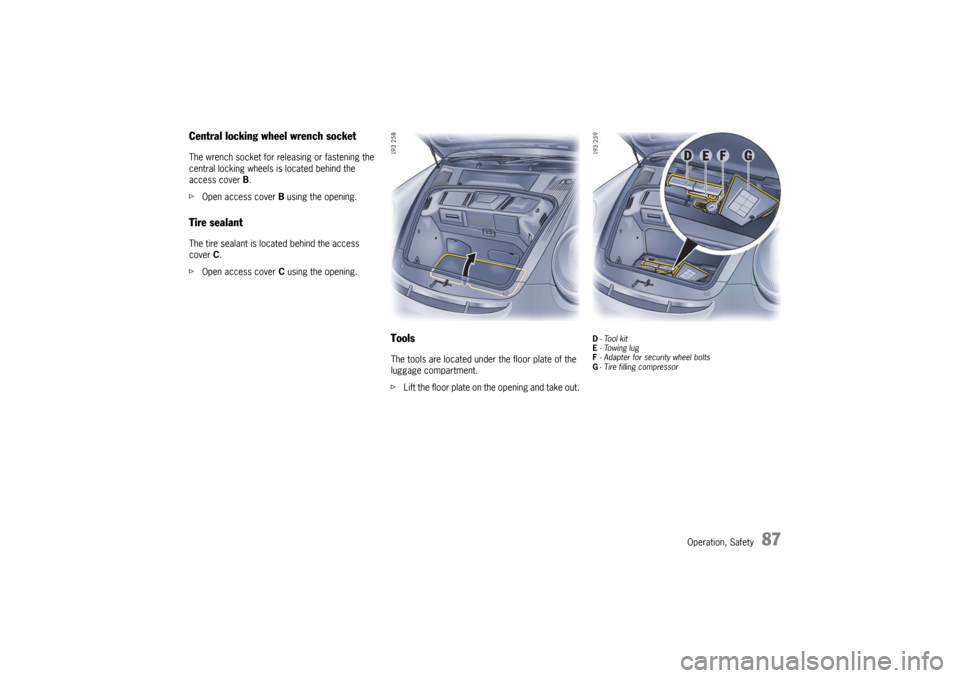
Operation, Safety
87
Central locking wheel wrench socketThe wrench socket for releasing or fastening the
central locking wheels is located behind the
access cover B.
fOpen access cover B using the opening.Tire sealantThe tire sealant is located behind the access
cover C.
fOpen access cover C using the opening.
ToolsThe tools are located under the floor plate of the
luggage compartment.
fLift the floor plate on the opening and take out.
D-Tool kit
E- Towing lug
F- Adapter for security wheel bolts
G- Tire filling compressor
10_GT3_21.book Seite 87 Donnerstag, 4. Juni 2009 12:48 12
Page 170 of 251

Maintenance, Car Care
169
How Emission Control Works When an automobile engine is running, it uses
energy generated through the combustion of a
mixture of air and fuel. Depending on whether a
car is driven fast or slowly or whether the engine
is cold or hot, some of the fuel (hydrocarbons)
may not be burned completely, but may be
discharged into the engine crankcase or exhaust
system. Additonal hydrocarbons may enter the
atmosphere through evaporation of fuel from the
fuel tank. These hydrocarbons (HC), when
released into the air, contribute to undesirable
pollution.
In addition, carbon monoxide (CO) and oxides of
nitrogen (NOx) contribute to engine emissions.
They, too, are formed during the combustion
process and discharged into the exhaust system.
To reduce these pollutants, your Porsche is
equipped with a precisely calibrated fuel injection
system to assure a finely balanced air/fuel mixture
under all operating conditions.
Oxygen sensor The oxygen sensor, installed in the exhaust pipe
continuously senses the oxygen content of the
exhaust and signals the information to an
electronic control unit. The control unit corrects
the air/fuel ratio, so the engine always receives an
accurately metered air/fuel mixture. Crankcase ventilation Through crankcase ventilation, undesirable
emissions from the engine crankcase are not
permitted to reach the outside atmosphere. These
emissions are recirculated from the crankcase to
the air intake system. From here the emissions
mix with the intake air and are later burned in the
engine. Catalytic converters The catalytic converters are efficient “clean-up”
devices built into the exhaust system of the
vehicle. The catalytic converters burn the undesi-
rable pollutants in the exhaust gas before it is
released into the atmosphere.
The exclusive use of unleaded fuel is criti-
cally important for the life of the catalytic
converters. Therefore, only unleaded fuel
must be used.The catalytic converters will be damaged by:
– push or tow starting the vehicle
– misfiring of the engine
– turning off the ignition while the vehicle is
moving or
– driving until the fuel tank is completely empty
– by other unusual operating conditions.
fDo not continue to operate your vehicle under
these conditions, since raw fuel might reach
the catalytic converters. This could result in
overheating of the converters. Federal law
prohibits use of leaded fuel in this car.
10_GT3_21.book Seite 169 Donnerstag, 4. Juni 2009 12:48 12
Page 172 of 251
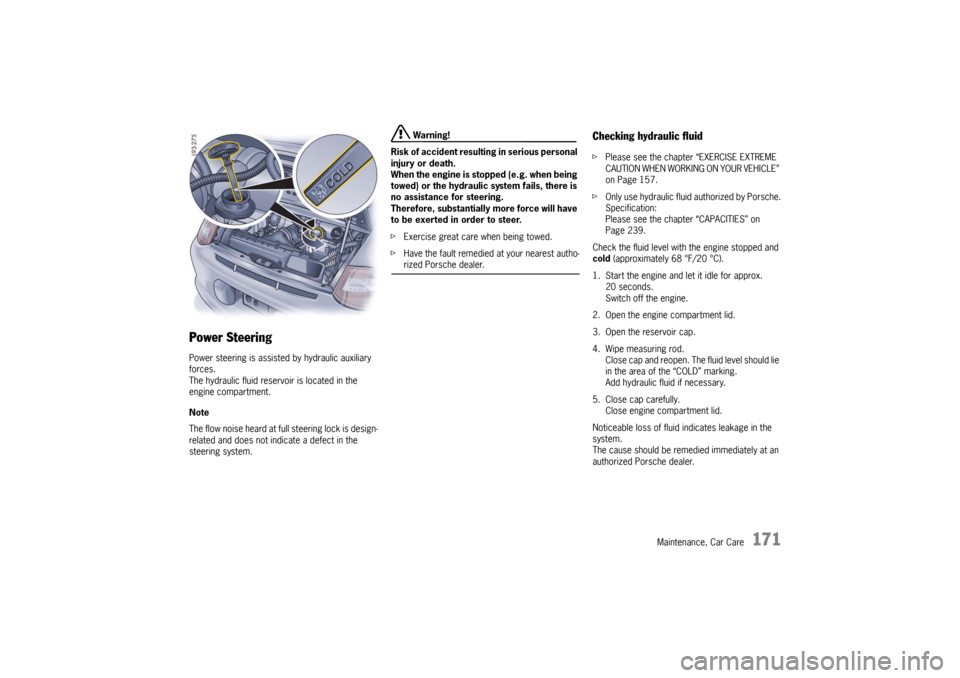
Maintenance, Car Care
171
Power Steering Power steering is assisted by hydraulic auxiliary
forces.
The hydraulic fluid reservoir is located in the
engine compartment.
Note
The flow noise heard at full steering lock is design-
related and does not indicate a defect in the
steering system.
Warning!
Risk of accident resulting in serious personal
injury or death.
When the engine is stopped (e.g. when being
towed) or the hydraulic system fails, there is
no assistance for steering.
Therefore, substantially more force will have
to be exerted in order to steer.
fExercise great care when being towed.
fHave the fault remedied at your nearest autho-rized Porsche dealer.
Checking hydraulic fluid fPlease see the chapter “EXERCISE EXTREME
CAUTION WHEN WORKING ON YOUR VEHICLE”
on Page 157.
fOnly use hydraulic fluid authorized by Porsche.
Specification:
Please see the chapter “CAPACITIES” on
Page 239.
Check the fluid level with the engine stopped and
cold (approximately 68 °F/20 °C).
1. Start the engine and let it idle for approx.
20 seconds.
Switch off the engine.
2. Open the engine compartment lid.
3. Open the reservoir cap.
4. Wipe measuring rod.
Close cap and reopen. The fluid level should lie
in the area of the “COLD” marking.
Add hydraulic fluid if necessary.
5. Close cap carefully.
Close engine compartment lid.
Noticeable loss of fluid indicates leakage in the
system.
The cause should be remedied immediately at an
authorized Porsche dealer.
10_GT3_21.book Seite 171 Donnerstag, 4. Juni 2009 12:48 12
Page 183 of 251
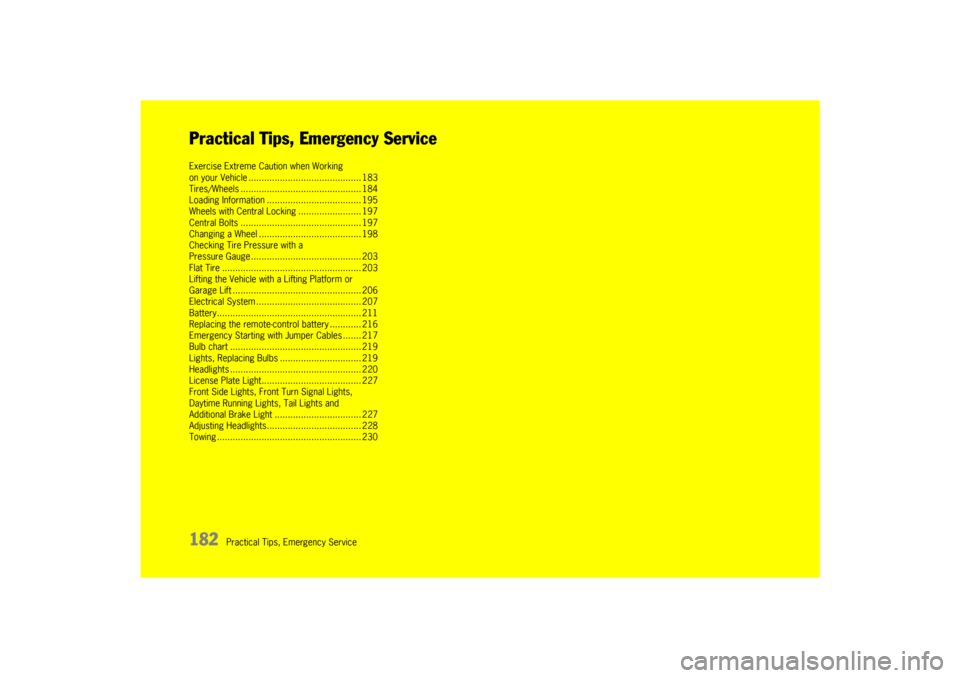
182
Practical Tips, Emergency Service
Practical Tips, Emergency ServiceExercise Extreme Caution when Working
on your Vehicle ........................................... 183
Tires/Wheels .............................................. 184
Loading Information .................................... 195
Wheels with Central Locking ........................ 197
Central Bolts .............................................. 197
Changing a Wheel ....................................... 198
Checking Tire Pressure with a
Pressure Gauge .......................................... 203
Flat Tire ..................................................... 203
Lifting the Vehicle with a Lifting Platform or
Garage Lift ................................................. 206
Electrical System ........................................ 207
Battery....................................................... 211
Replacing the remote-control battery ............ 216
Emergency Starting with Jumper Cables ....... 217
Bulb chart .................................................. 219
Lights, Replacing Bulbs ............................... 219
Headlights .................................................. 220
License Plate Light...................................... 227
Front Side Lights, Front Turn Signal Lights,
Daytime Running Lights, Tail Lights and
Additional Brake Light ................................. 227
Adjusting Headlights.................................... 228
Towing ....................................................... 230
10_GT3_21.book Seite 182 Donnerstag, 4. Juni 2009 12:48 12
Page 185 of 251
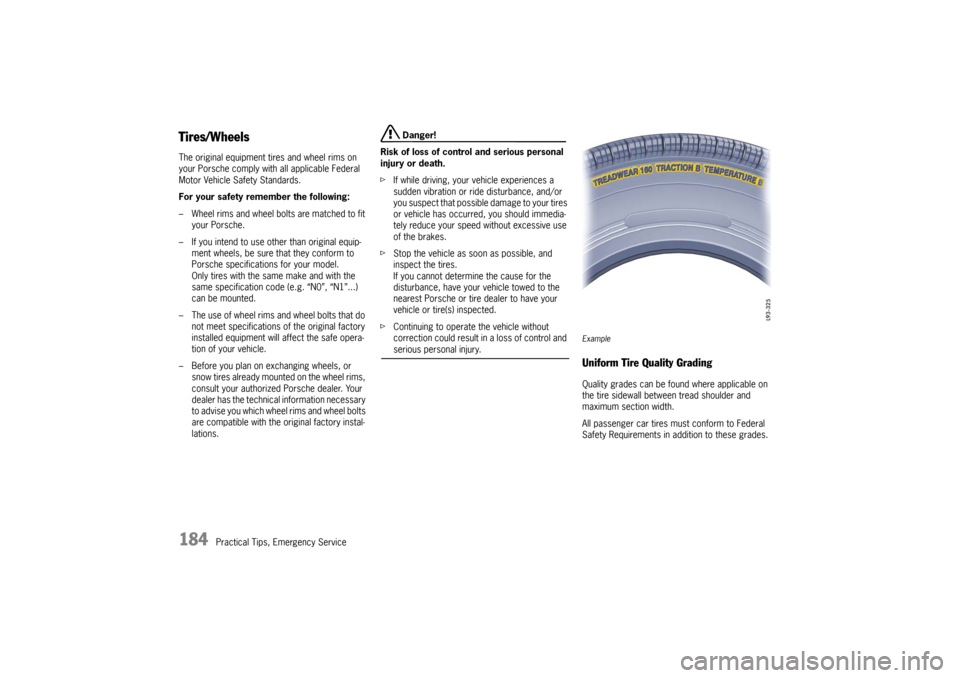
184
Practical Tips, Emergency Service
Tires/Wheels The original equipment tires and wheel rims on
your Porsche comply with all applicable Federal
Motor Vehicle Safety Standards.
For your safety remember the following:
– Wheel rims and wheel bolts are matched to fit
your Porsche.
– If you intend to use other than original equip-
ment wheels, be sure that they conform to
Porsche specifications for your model.
Only tires with the same make and with the
same specification code (e.g. “N0”, “N1”...)
can be mounted.
– The use of wheel rims and wheel bolts that do
not meet specifications of the original factory
installed equipment will affect the safe opera-
tion of your vehicle.
– Before you plan on exchanging wheels, or
snow tires already mounted on the wheel rims,
consult your authorized Porsche dealer. Your
dealer has the technical information necessary
to advise you which wheel rims and wheel bolts
are compatible with the original factory instal-
lations.
Danger!
Risk of loss of control and serious personal
injury or death.
fIf while driving, your vehicle experiences a
sudden vibration or ride disturbance, and/or
you suspect that possible damage to your tires
or vehicle has occurred, you should immedia-
tely reduce your speed without excessive use
of the brakes.
fStop the vehicle as soon as possible, and
inspect the tires.
If you cannot determine the cause for the
disturbance, have your vehicle towed to the
nearest Porsche or tire dealer to have your
vehicle or tire(s) inspected.
fContinuing to operate the vehicle without
correction could result in a loss of control and serious personal injury.
ExampleUniform Tire Quality GradingQuality grades can be found where applicable on
the tire sidewall between tread shoulder and
maximum section width.
All passenger car tires must conform to Federal
Safety Requirements in addition to these grades.
10_GT3_21.book Seite 184 Donnerstag, 4. Juni 2009 12:48 12
Page 218 of 251
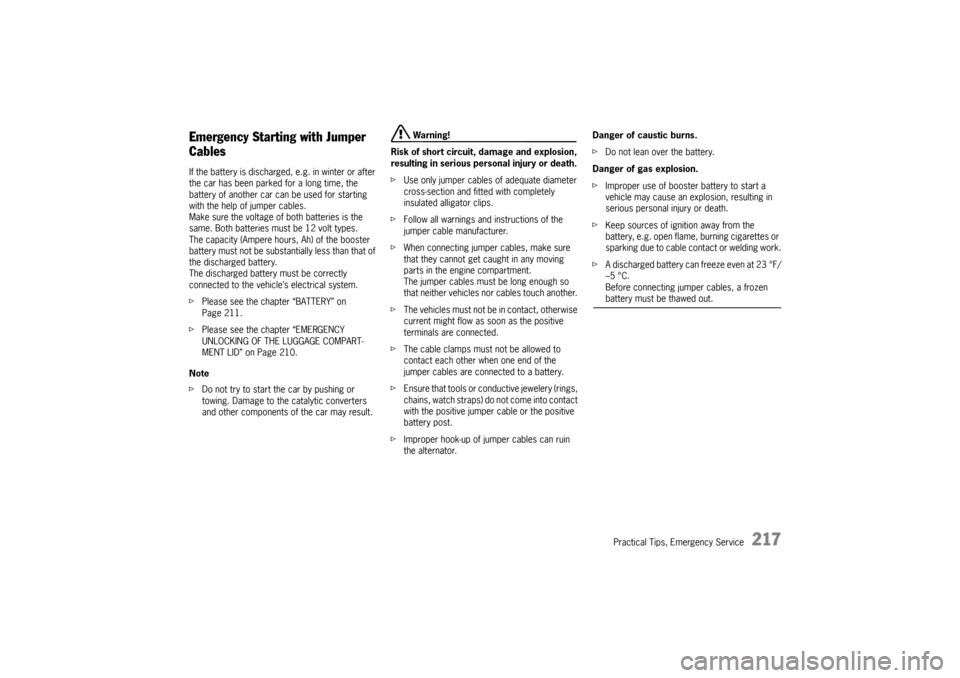
Practical Tips, Emergency Service
217
Emergency Starting with Jumper
Cables If the battery is discharged, e.g. in winter or after
the car has been parked for a long time, the
battery of another car can be used for starting
with the help of jumper cables.
Make sure the voltage of both batteries is the
same. Both batteries must be 12 volt types.
The capacity (Ampere hours, Ah) of the booster
battery must not be substantially less than that of
the discharged battery.
The discharged battery must be correctly
connected to the vehicle’s electrical system.
fPlease see the chapter “BATTERY” on
Page 211.
fPlease see the chapter “EMERGENCY
UNLOCKING OF THE LUGGAGE COMPART-
MENT LID” on Page 210.
Note
fDo not try to start the car by pushing or
towing. Damage to the catalytic converters
and other components of the car may result.
Warning!
Risk of short circuit, damage and explosion,
resulting in serious personal injury or death.
fUse only jumper cables of adequate diameter
cross-section and fitted with completely
insulated alligator clips.
fFollow all warnings and instructions of the
jumper cable manufacturer.
fWhen connecting jumper cables, make sure
that they cannot get caught in any moving
parts in the engine compartment.
The jumper cables must be long enough so
that neither vehicles nor cables touch another.
fThe vehicles must not be in contact, otherwise
current might flow as soon as the positive
terminals are connected.
fThe cable clamps must not be allowed to
contact each other when one end of the
jumper cables are connected to a battery.
fEnsure that tools or conductive jewelery (rings,
chains, watch straps) do not come into contact
with the positive jumper cable or the positive
battery post.
fImproper hook-up of jumper cables can ruin
the alternator. Danger of caustic burns.
fDo not lean over the battery.
Danger of gas explosion.
fImproper use of booster battery to start a
vehicle may cause an explosion, resulting in
serious personal injury or death.
fKeep sources of ignition away from the
battery, e.g. open flame, burning cigarettes or
sparking due to cable contact or welding work.
fA discharged battery can freeze even at 23 °F/
–5 °C.
Before connecting jumper cables, a frozen
battery must be thawed out.
10_GT3_21.book Seite 217 Donnerstag, 4. Juni 2009 12:48 12
Page 231 of 251
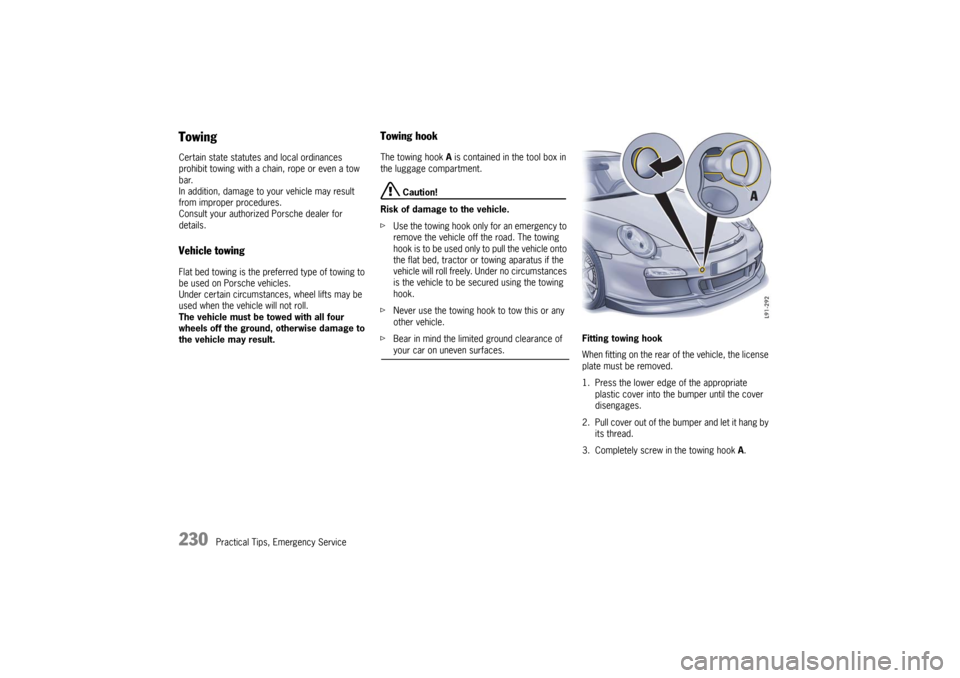
230
Practical Tips, Emergency Service
Towing Certain state statutes and local ordinances
prohibit towing with a chain, rope or even a tow
bar.
In addition, damage to your vehicle may result
from improper procedures.
Consult your authorized Porsche dealer for
details. Vehicle towing Flat bed towing is the preferred type of towing to
be used on Porsche vehicles.
Under certain circumstances, wheel lifts may be
used when the vehicle will not roll.
The vehicle must be towed with all four
wheels off the ground, otherwise damage to
the vehicle may result.
Towing hook The towing hook A is contained in the tool box in
the luggage compartment.
Caution!
Risk of damage to the vehicle.
fUse the towing hook only for an emergency to
remove the vehicle off the road. The towing
hook is to be used only to pull the vehicle onto
the flat bed, tractor or towing aparatus if the
vehicle will roll freely. Under no circumstances
is the vehicle to be secured using the towing
hook.
fNever use the towing hook to tow this or any
other vehicle.
fBear in mind the limited ground clearance of your car on uneven surfaces.Fitting towing hook
When fitting on the rear of the vehicle, the license
plate must be removed.
1. Press the lower edge of the appropriate
plastic cover into the bumper until the cover
disengages.
2. Pull cover out of the bumper and let it hang by
its thread.
3. Completely screw in the towing hook A.
10_GT3_21.book Seite 230 Donnerstag, 4. Juni 2009 12:48 12
Page 232 of 251
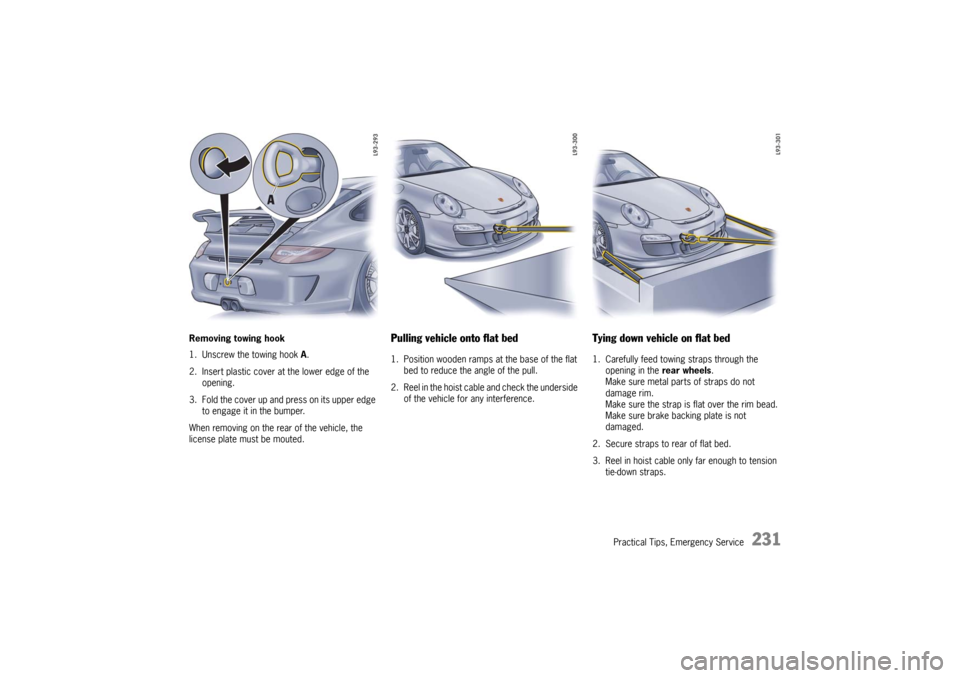
Practical Tips, Emergency Service
231
Removing towing hook
1. Unscrew the towing hook A.
2. Insert plastic cover at the lower edge of the
opening.
3. Fold the cover up and press on its upper edge
to engage it in the bumper.
When removing on the rear of the vehicle, the
license plate must be mouted.
Pulling vehicle onto flat bed 1. Position wooden ramps at the base of the flat
bed to reduce the angle of the pull.
2. Reel in the hoist cable and check the underside
of the vehicle for any interference.
Tying down vehicle on flat bed 1. Carefully feed towing straps through the
opening in the rear wheels.
Make sure metal parts of straps do not
damage rim.
Make sure the strap is flat over the rim bead.
Make sure brake backing plate is not
damaged.
2. Secure straps to rear of flat bed.
3. Reel in hoist cable only far enough to tension
tie-down straps.
10_GT3_21.book Seite 231 Donnerstag, 4. Juni 2009 12:48 12
Page 233 of 251

232
Practical Tips, Emergency Service 4. Carefully feed towing straps through the
opening in the front wheels.
Make sure metal parts of straps do not
damage rim.
Make sure the strap is flat over the rim bead.
Make sure brake backing plate is not
damaged.
5. Secure straps to front of flat bed.
6. Release tension on hoist cable, but do not
disconnect.
Use hoist cable as a safety cable.
10_GT3_21.book Seite 232 Donnerstag, 4. Juni 2009 12:48 12